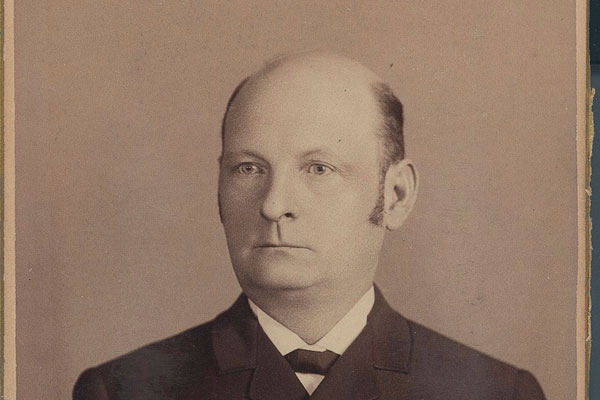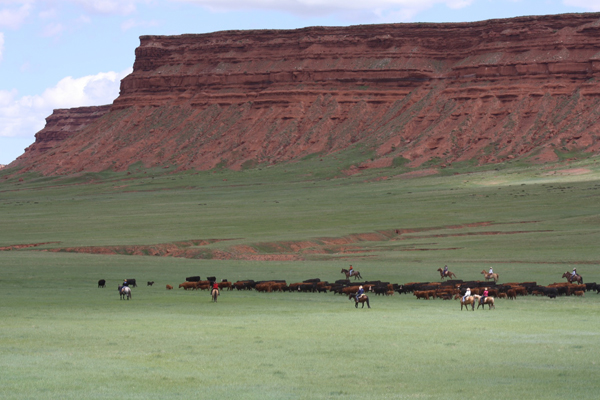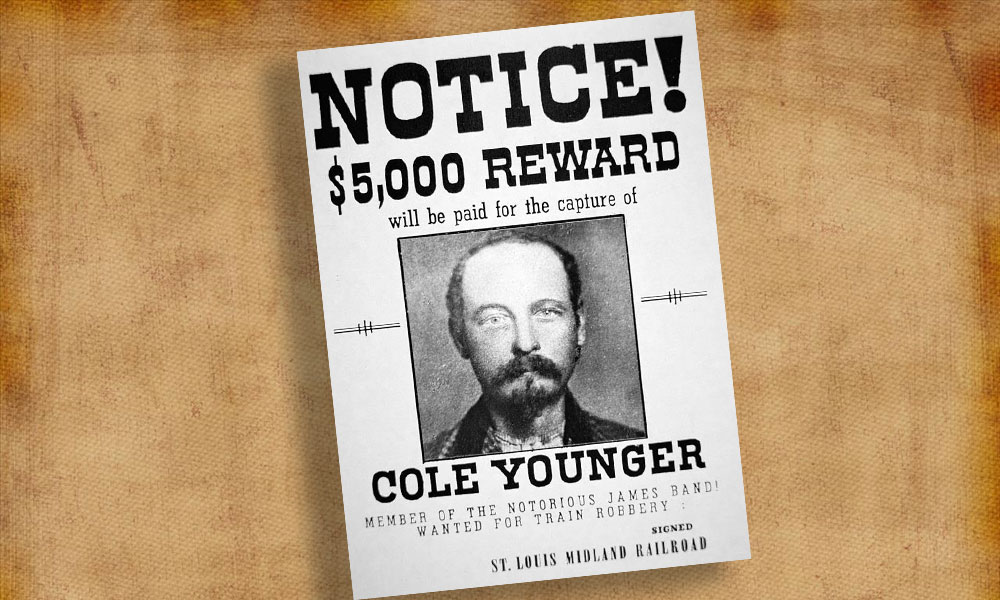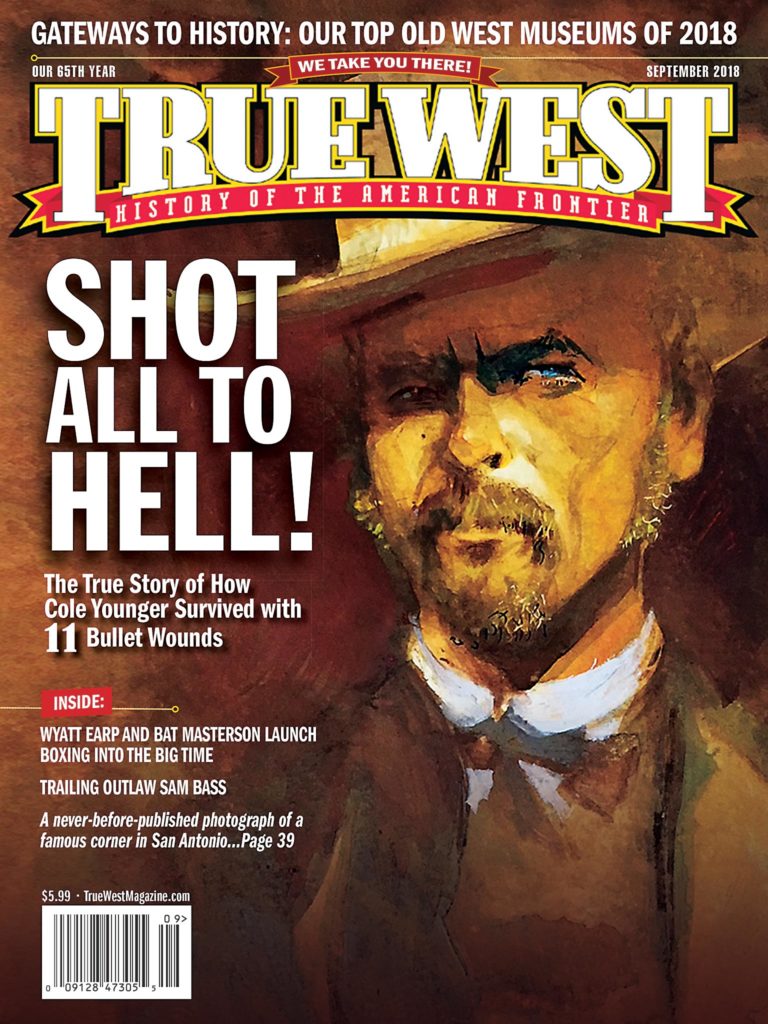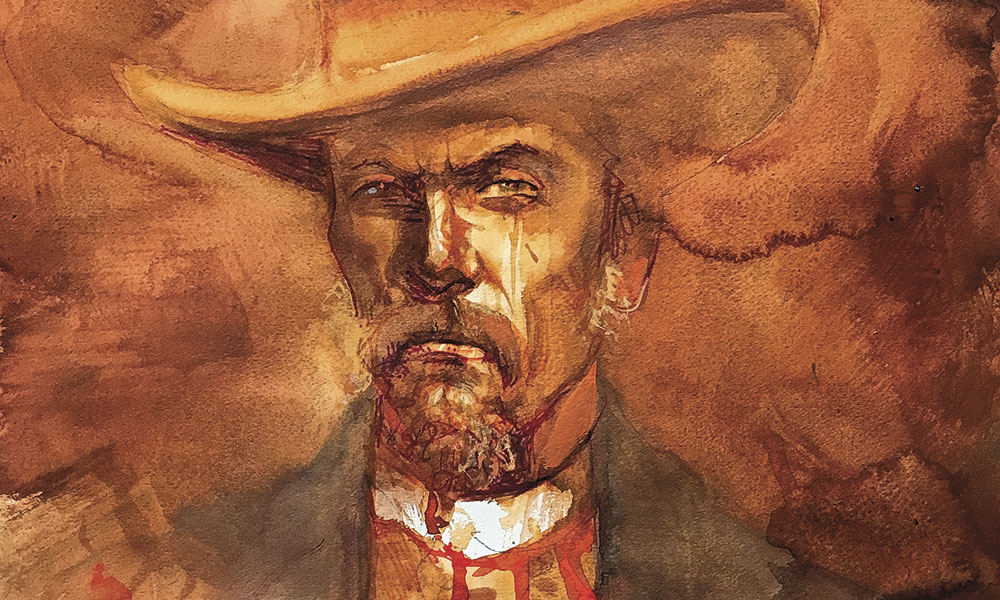
Cole Younger has to be the toughest outlaw who ever lived. In addition to having 11 slugs in his body, Cole had to guide his horse with his knees after a Northfield Raid defender shot away the reins to his bridle with birdshot. Pursued by more than 1,000 farmers hungry for the reward ($10,000), Cole and his two brothers were captured at Hanska Slough and taken to nearby Madelia, Minnesota.
After a two-week run in the constant rain, utilizing old newspapers as bandages on multiple wounds and wading through swollen rivers, the outlaw leader finally removed his boots.
“And then my toenails fell off….”
—Cole Younger, remembering his capture on September 21, 1876
What follows is how all this came down.
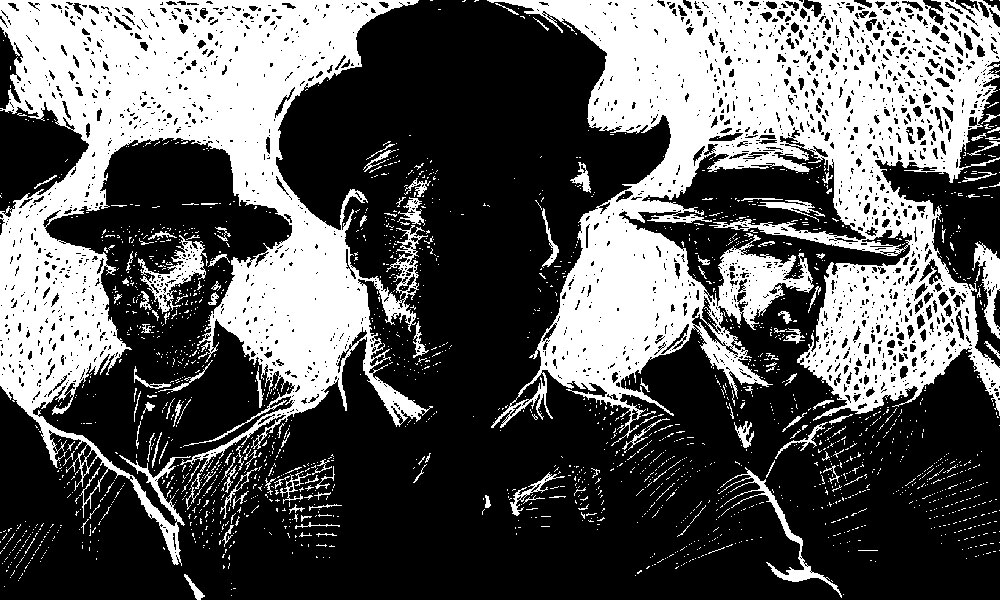
— Illustrations by Bob Boze Bell —
The Battle of Northfield: James-Younger Gang vs Townsmen of Northfield
September 7, 1876
t’s just past 2 p.m. when three horsemen, wearing matching white linen dusters, dismount in front of the First National Bank in Northfield, Minnesota. After tying their reins to hitching posts, they stroll to the corner (see Phase One map), sit on some dry goods boxes and exchange pleasantries with several locals.
Two more horsemen, also wearing linen dusters, approach Division Street from the south. Several minutes later, three more horsemen, dressed in matching dusters, cross the iron bridge and stop in the center of Mill Square. The three men seated on the corner stand up, walk back to the bank and then go inside.
Two mounted men, who came from the south, pull up in front of the bank. One of them, Cole Younger, says under his breath, “You’d better close the door,” and the riders both dismount. His partner Clell Miller leads his horse to the bank door and shuts it. In the middle of the street, Cole scans the roadway while pretending to tighten the cinch on his saddle.
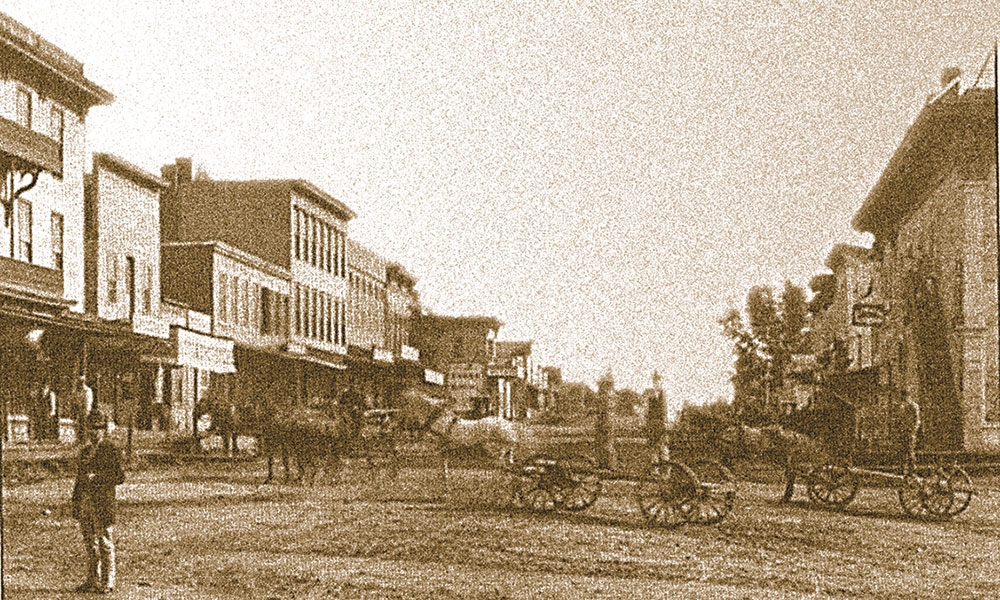
— All photos courtesy Northfield Historical Society unless otherwise noted —
Several townsmen are suspicious of all these uniformed strangers, and one local, J.S. Allen, walks to the bank and looks in the window. His suspicions confirmed, Allen turns to go alert the other citizens when he is confronted by Miller, who has just closed the door. Grabbing Allen by the collar, the outlaw says, “You son of a bitch, don’t you holler.”
Allen breaks free and runs up the boardwalk, shouting, “Get your guns boys. They’re robbing the bank!”
Cole immediately mounts his horse and pulls his revolver, firing it in the air as a signal for the three horsemen in Mill Square to come quick—the gang has been discovered.
At almost the same instant, those outside hear a shot from inside the bank. The three horsemen from the square pull their pistols and ride into the engagement, firing and yelling at bystanders to “get in.”
Miller grabs the reins of his horse to mount up. As he steps into the stirrup, birdshot pellets fired by local Elias Stacy hit Miller in the face, and he falls backward to the ground. Another townsman, A.R. Manning, aims his single-shot Remington rifle and hits Bob Younger’s horse, which is tied in front of the bank. Struck in the neck, the animal drops in its tracks.
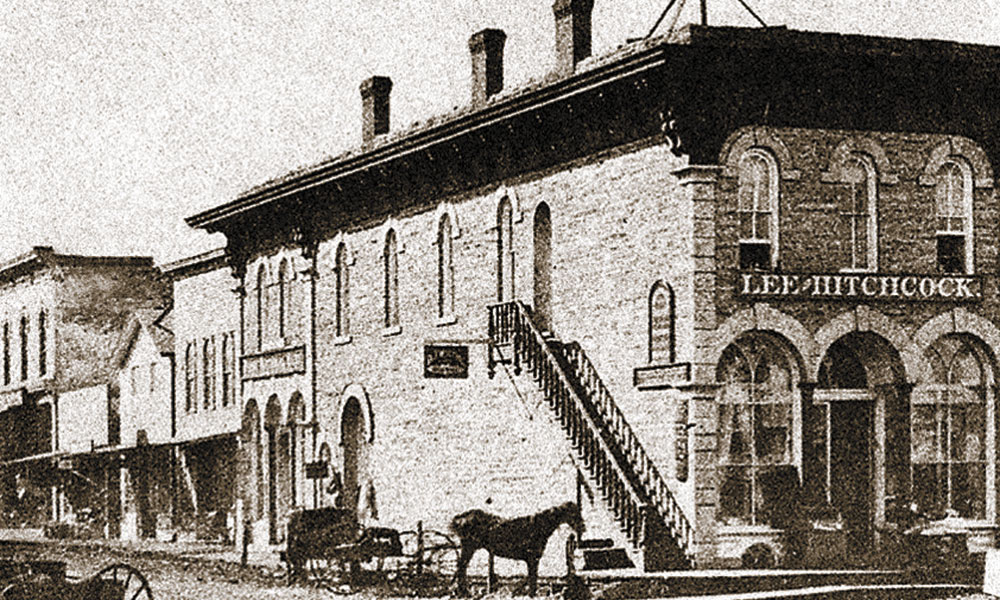
— Remington rifle, below, courtesy EMF Co. —
Four horsemen ride back and forth, firing at any who dare to show their face. Instead of cowering, the locals come out with everything they have: Flintlocks, fowling pieces with mismatched ammunition, birdshot plunkers, frying pans and rocks. One pesky storekeeper even aims an empty pistol to draw fire and taunt the brigands.
A Swede named Gustavson, who doesn’t speak English, comes out of a cellar saloon and is shot in the top of his skull after failing to respond to one robber’s command. (He dies several days later.)
Suffering from his face wounds, Miller remounts and pulls out his pistols. As he turns his horse to ride up Division Street, he is hit again, the bullet severing the outlaw’s subclavian artery, and he falls to the ground in a heap.
Cole rides over to Miller and dismounts. Cole sees the blank stare of death stamped on Miller’s bloody face. As he leans over Miller, a bullet rips into Cole’s left hip.
The elder Younger grabs Miller’s two revolvers and remounts. Birdshot and buckshot whistle past his ears as Cole again rides to the bank door and pleads for the boys to leave. “I could not imagine what was keeping them so long,” Cole later says.
Hearing the incessant firing from the street and the multiple pleadings of Cole, the robbers inside the bank become increasingly desperate. (See “Inside the Bank” sidebar.)
Seeing a chance to escape, teller Alonzo Bunker dashes out the back door and is chased by Charlie Pitts. Firing twice, Pitts hits Bunker in the shoulder, but the banker escapes. With their plan unraveling at every turn, the outlaws finally heed Cole’s third call and prepare to leave.
Outside, A.R. Manning bravely steps from behind the stairway at the corner of Scriver’s and takes quick aim at outlaw Bill Chadwell (a.k.a. Stiles). Chadwell topples from his horse, shot through the heart. (Manning is also the one who shot Cole in the hip.)
“For God’s sake come out,” Cole pleads from the doorway of the bank, more desperate than ever. “They are shooting us all to pieces.”
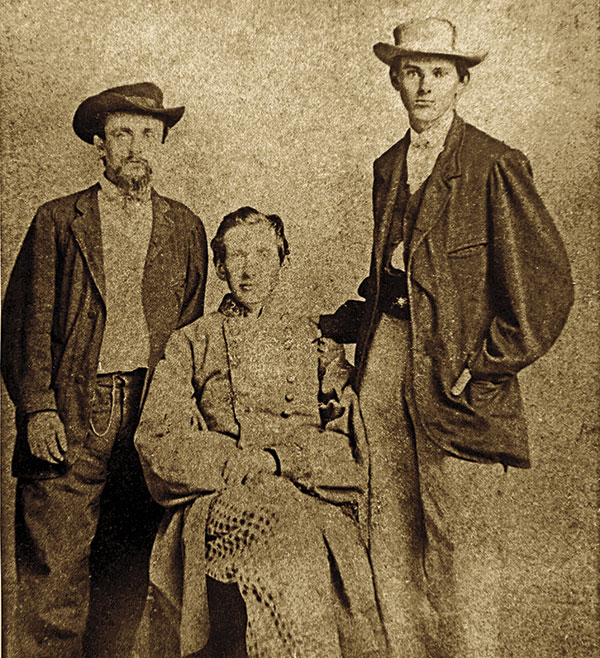
— Courtesy Robert G. McCubbin Collection —
Pitts, Bob Younger and Frank James finally emerge from the bank. The last robber to leave climbs on the counter, turns and fatally shoots a stumbling, semi-coherent Joseph Heywood in the head.
Bob runs to the corner to confront Manning and several other townsmen. (Some sources claim Bob is merely heading for his horse, which has already been shot dead by Manning.)
While Bob plays hide-and-seek with Manning through the openings of Scriver’s stairs, an upper-story shot from across the street rips into Bob’s right arm, breaking the bone at the elbow. Undeterred, he deftly shifts his pistol to his left hand and continues firing.
As the others flee, Cole rides directly into the line of fire to pick up his little brother. A bullet severs one of Cole’s bridle reins, forcing him to guide his mount with his knee and hand. As he turns his horse for Bob to climb aboard, Cole is hit in both the side and shoulder. His hat is also shot off. Another bullet rips away the back of his saddle. (One account reports Cole urges his brother to run, then picks him up a block away.)
The six wounded men give a meek rebel yell as they head south out of town. Although they have survived the Battle of Northfield, their painful ride has just begun.
Six Factors that Unhinge the Raid
•
The matched outfits (white linen dusters) immediately arouse suspicion among the townspeople.
•
Hardly anyone in that part of the country rides saddle horses (most use buggies or wagons); so the sight of eight, uniformed horsemen draws attention.
•
At the time of the shoot-out, it is hunting season, and many guns in Northfield are loaded and waiting. As Adelbert Ames later says, “Every old musket, shotgun and pistol was drawn from its hiding place.”
•
Although Jesse James and his men chose a rich target, they strike when too many locals are on the streets. Cole Younger later writes, “I remarked to [Clell] Miller about the crowd and said, ‘Surely the boys will not go into the bank with so many people about.’”
•
In the south, where most of the James-Younger heists were committed, the poor locals didn’t have much compassion for banks. Consequently, the posses that chased the gang gave up easily. But in Northfield, the outlaws encounter fierce resistance. Why? Everyone who shoots at them has money in the bank.
•
In later years, Cole admits that, unbeknownst to him, Charlie Pitts, Bob Younger and Frank James had drank a quart of whiskey before entering the bank. He concludes that their drinking was the “initial blunder at Northfield.” When the three robbers enter the bank, teller Alonzo Bunker smells the “stink of liquor” on them. The three bank employees undoubtedly feel they are dealing with three slow-thinking drunks, and in fact, they are. Once you consider the robbers’ actions inside the bank, in the light of being drunk, it all makes sense.
In the end, what can go wrong, does. What worked before, doesn’t. In seven short minutes, the lottery-driven dreams of Missouri’s premier outlaws are blasted to kingdom come in a hail of mismatched, ugly bullets.
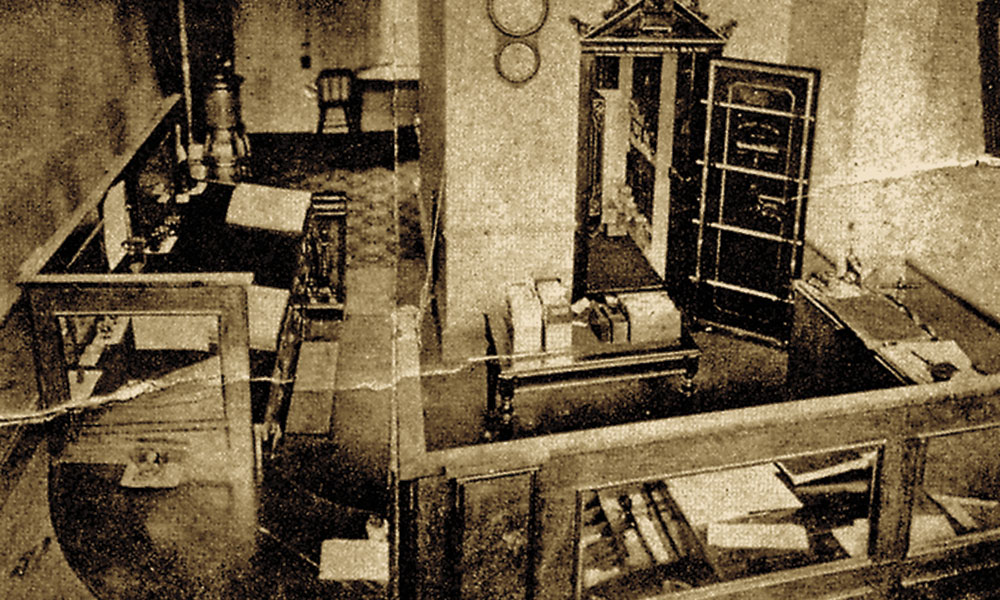
Inside the Bank
Precious seconds turn to minutes as the three hapless bank robbers inside the bank become stymied by three bank employees playing dumb like a fox.
First, the robbers demand to know who is the cashier. But because the official cashier is out of town, all three employees honestly answer in the negative. Their response throws off the outlaws from the start, and things will only become worse.
Bookkeeper Joseph Heywood tells the bandits the safe is on a time lock and can’t be opened. It’s a lie. All the robbers need to do is turn the latch and the safe will open, but they never even try.
When one robber starts to go inside the vault to check it out, Heywood slams the door on him, bruising the outlaw. When the outlaw leader threatens him, Heywood yells at the top of his lungs, “Murder! Murder! Murder!”
Perhaps trying to shut him up, a robber cold-cocks Heywood with a pistol. The robbers then drag him inside the vault and try making him open the safe, but he’s unresponsive. The bandits even fire a bullet next to his head (the shot heard outside) to scare him, but it doesn’t work. Pulling a knife, one robber threatens to slit Heywood’s throat and then nicks the bookkeeper’s neck, but Heywood still won’t, or can’t, respond.
After teller Alonzo Bunker escapes, the thwarted outlaws get ready to leave empty-handed. A frustrated Bob Younger scoops up $26 and some change off the counter.
“The last robber to leave the bank,” Frank Wilcox later testifies, “leaped upon the cashier’s desk as he was leaving, and while he stood there, turned and shot Heywood as Heywood was staggering about the room in an effort to prevent himself from falling.”
Three Phases of the Gun Battle
Phase One
As the gang crosses the iron bridge, two by two, the townsmen begin to take notice. Frank James, Bob Younger and Charlie Pitts tie their horses in front of the bank and walk to the corner to sit on dry goods boxes. As soon as they see the Jesse James-led trio arrive in the square, the men get up, walk to the bank and go inside.
Phase Two
After J.S. Allen sounds the alarm, Cole Younger fires his warning shot, and Jim Younger, Jesse James and Bill Chadwell begin riding the perimeter of the square, demanding that bystanders “get in.” Within moments, the locals begin shooting at the riders.
Phase Three
As the seconds turn into minutes, the mounted riders are driven from Mill Square by gunfire directed at them from the Dampier House and from armed locals by the hardware stores. Choked off from the only bridge crossing, the gang retreats south out of town. They outlaws eventually cross a bridge in Dundas.
Aftermath: Odds & Ends
One of the mysteries surrounding the bank raid is where were the sheriff, the city marshal or lawmen of any kind? Local tradition says the chief of police hid in a dry goods box in the back of a store and didn’t emerge until after the battle. This legend has been disproved by author and researcher John J. Koblas, who adds, “There really weren’t any sheriff types in Northfield. It is believed the chief of police, Elias Hobbs, was involved in the battle.”
In their haste to flee the bank, the outlaws left behind a duster and a grain sack with the initials H.C.A. (What the initials stood for has never been solved.) In the street, the citizens found two dead men, a single spur and two pistols, one of them being an ivory-handled Colt .45. Bob Younger’s dead horse yielded a fine saddle (illustrated here), which is now prominently displayed in the Northfield Museum.
After the Youngers were captured at Hanska Slough, a Faribault doctor extracted the ball that was still lodged in Cole Younger’s hip and gave it to A.R. Manning, the man who had fired it. Manning carried it as a good luck charm for the rest of his life.
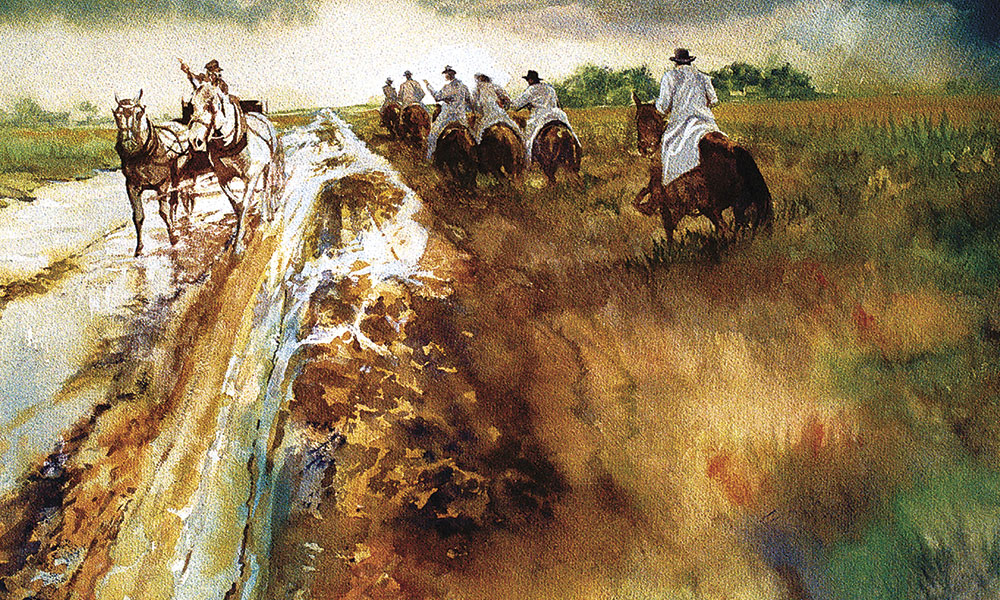
— Illustration by Bob Boze Bell —
Strange Stops on a Wayward, Wet Journey
• South of Northfield, the gang paused along the banks of the Cannon River to cleanse their wounds. A local man, Philip Empey, came by with a team of gray horses, hauling rails. The robbers waylaid him and stole one of the horses for Bob Younger. As the gang rode across the Dundas Bridge, several locals yelled at them. One asked, “What are you doing with Phil Empey’s horse?”
• In Dundas, eyewitnesses confirmed that one of the outlaws (probably Cole Younger) cursed at the others for not following orders and for being drunk. As the gang rode by, a St. Paul drummer (salesman) remarked, “If Sitting Bull was after you, you’d ride a little faster.” (George Custer’s final battle, June 26, was recent news.) One of the bandits heard the remark and pulled out his pistol, sneering, “Get in there, you son of a bitch.” The salesman got “in.”
• A half-mile beyond Dundas, the gang stopped at a farm and asked for a pail of water. As Robert Donaldson procured a bucket, he inquired about the wounded rider. He was told the injured man had been shot by a “blackleg” in Northfield, and that the gang killed the assailant. The farmer asked the name of the man they killed. One of the men yelled, “Stiles,” which was outlaw Bill Chadwell’s alias.
• A farmer driving a wagon crossed paths with the gang and noticed Cole and Jim Younger were riding on either side of their brother Bob, while holding him in the saddle. The farmer asked if the wounded man is a prisoner. One of the gang assured the farmer the man was their prisoner, and that they were taking him to jail. The perplexed farmer told them they are heading in the wrong direction. One of the outlaws turned, saying, “Oh no! We’re taking the right way.”
• The gang traveled 11 miles in two hours. Beyond Millersburg, the men stopped a farmer and stole his horse, then stopped another farmer for his saddle, but the girth on this saddle broke, spilling Bob Younger into the road. Bob was once again put up to ride behind Cole, and the men kept going.
• Responding to telegraph messages, 15 men from Faribault arrived in Shieldsville, ahead of the gang. Unfortunately, they retired inside Haggerty’s Saloon for some liquid courage and left their guns outside. The gang rode into town and stopped at a pump to take water for their horses and their wounds. Someone from inside the saloon tried to come out, but the gang buffaloed them and rode off shooting as they left.
• The Faribault posse pursued the gang on the Old Dodd Road, firing at them as they ascended a hill. The gang returned fire. Charlie Pitts was thrown from his horse. As Pitts remounted, his saddle cinch broke, and he fell again. Pitts jumped up behind Bob Younger (whose horse was being led by Cole), and he and the rest of the robbers disappeared into the “Big Woods.”
• A torrential downpour moved through the area. Heavy rains would continue on and off for two weeks.
• Former Civil War Union Gen. Edmund Pope was put in charge of the robber roundup operation. He established command headquarters at Eagle Lake, and he stationed law enforcement officers, troops and volunteers on picket lines from the Wardlaw Ravine to the Waseca County line.
• Surrounded near German Lake, the gang abandoned its horses, tied them to trees and took only their bridles. The men then slipped through the picket lines on foot and escaped.
• On September 12, Faribault posse members found two of the outlaws’ horses about five miles north of Lake Elysian. They also found five saddles.
• Two or three miles from Mankato, the gang discovered a deserted farmhouse and holed up for two days and two nights. Although they had slipped through several dragnets, they traveled less than 50 miles in five days.
• Rewards for the robbers reached over $3,000 a man, and many in Minnesota and Iowa came down with “robber fever.”
• The rain continued to fall. Old-timers claimed it is the wettest two weeks in memory. All the streams were swollen, bridges were out and the entire area was a quagmire. The weather worked in favor of the robbers because their tracks were immediately wiped out by the rain.
• On September 13, a farm hand was kidnapped and forced to show the outlaws the way through Mankato and across the Minnesota River. “After about a mile,” Cole Younger later recounted, “we turned him loose.” Although the kid promised not to rat them out, the farm hand went to the sheriff and told all.
• A posse jumped the gang near Minneopa Falls, but they escaped, barely. The gang left behind “part of a roasted chicken, some green corn, a hat and a rubber overcoat.”
• Near Rush Lake, the robbers decided to split up. Jesse and Frank James
stole a horse and headed west, while the Youngers and Pitts headed southwest on foot.
• At the edge of Linden Lake, a father and his son were milking cows out on the road (the driest place near their farm). When two of the outlaws, Jim Younger and Charlie Pitts, passed by, the boy, Oscar Sorbel, told his father he thinks the men were the Northfield bank robbers, but his dad was not convinced. “No,” Ole Sorbel replied. “They was nice men.” Oscar watched the two men disappear into the timber. After warning three neighbors, Oscar took the harness off a draft horse and rode the seven miles to Madelia, spreading the news.
• Two separate posses converged on Hanska Slough and successfully blocked the Youngers’ escape route.
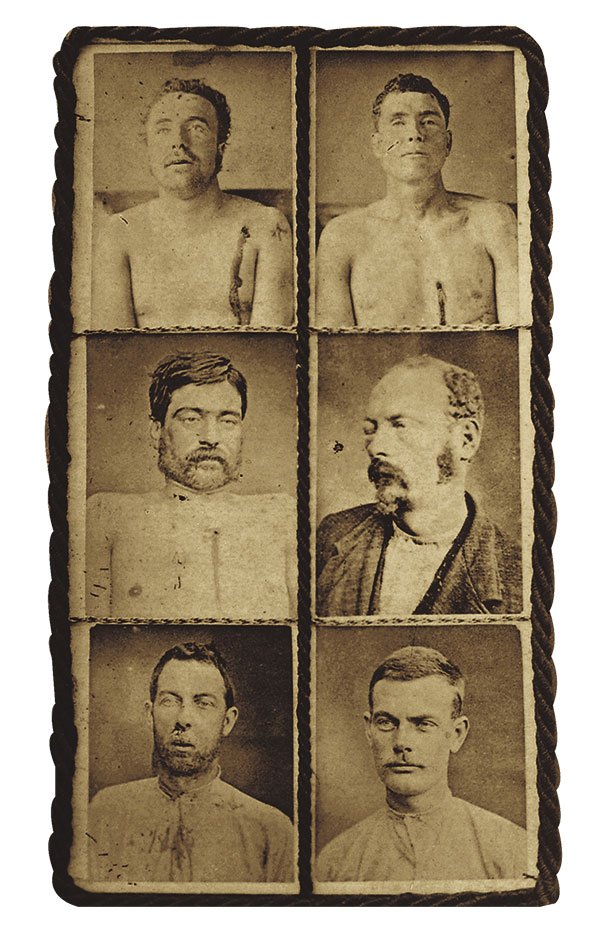
The Six Who Won’t Get Away
Photographs of the captured Younger gang members will be widely sold for four bits. This photo collage of dead and captured robbers (right) will be printed as cartes de visite and collected and sold throughout the United States.
https://truewestmagazine.com/cole-youngers-conversion/

